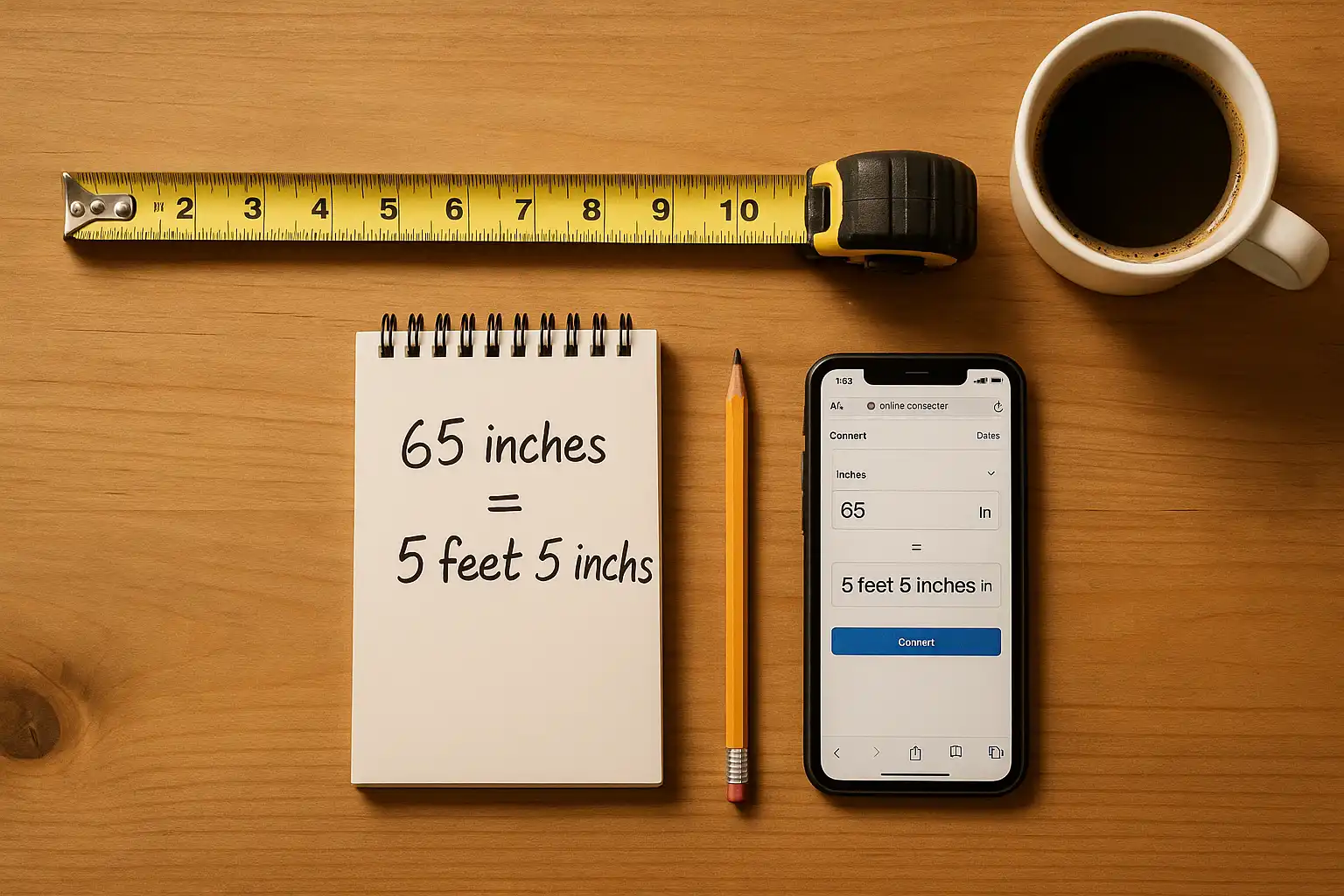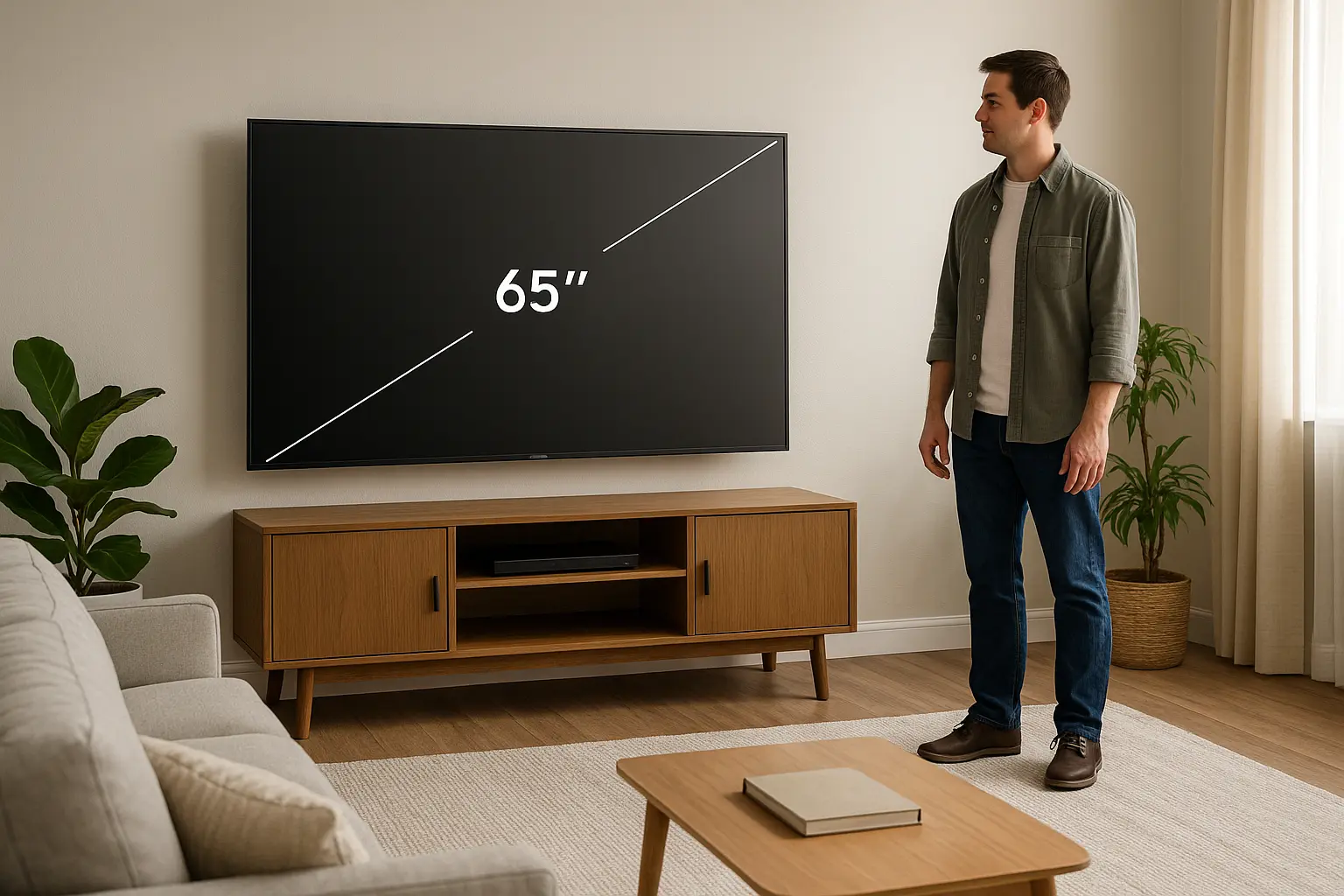Let me paint a familiar scene for you.
You’re browsing online maybe shopping for a new TV, checking out a bookshelf you’ve had your eye on, or even just measuring how tall your kid has gotten since the last growth spurt. Then boom, the number shows up: 65 inches. You stop. You squint a little. And you think… Okay, cool, but what does that even mean?
Because whether you’re decorating your space, buying something online, or just trying to make sense of someone’s height on a profile, knowing how tall is 65 inches in feet can be surprisingly helpful. And once you understand it, I promise, you’ll start seeing opportunities to use this little life skill everywhere.
If you’re anything like me (or, let’s be real, most of us in the U.S.), your brain starts doing this awkward mental math dance trying to convert inches into feet without a calculator, while also questioning your life choices for not remembering this stuff from middle school.
And that’s exactly why I wanted to write this guide.
The Quick Answer (for When You’re in a Hurry)
Let’s just start with the straight-up fact:
65 inches is equal to 5 feet and 5 inches.
That’s it. That’s the magic number. So if something (or someone) is 65 inches tall, just know that it stands a little over five feet about the height of an average adult woman, or slightly below shoulder height for someone around six feet tall.
You’re welcome to stop here. But if you’re curious about how that math actually works or why it’s super helpful to know keep reading. We’re going to break it down in plain English.
Let’s Make It Make Sense: Inches to Feet, the Easy Way

Okay, so here’s the deal: converting inches to feet isn’t hard. Like, at all. You just need to know one key rule:
There are 12 inches in a foot.
That’s it. Seriously. Every time you rack up 12 inches, you’ve built a full foot.
Now let’s apply that to 65 inches.
Step 1: Figure Out How Many Full Feet Are In 65 Inches
You take 65 and divide it by 12:
sqlCopyEdit65 ÷ 12 = 5 (with some left over)
That gives you 5 full feet. We’ve used up 60 of the 65 inches with those 5 feet.
Step 2: What About the Extra Inches?
We had 65 total inches. We used 60 of them for the feet. So:
CopyEdit65 - 60 = 5 inches
So the leftover is 5 inches.
Put it all together and you’ve got:
5 feet + 5 inches = 5’5″
And there you go. That’s how tall 65 inches is in feet.
Read This Guide Average Human Heights by Country
Why Bother Learning This? Because It’s Weirdly Useful
I get it you’re thinking, “Cool, but when am I ever going to need to do this?”
The answer? More often than you’d think.
1. People’s Heights Actually Make Sense Now
You’d be surprised how often people give their height in inches especially on medical forms, sports stats, or certain online profiles. Knowing that 65 inches is 5’5″ helps you instantly visualize someone’s height, without doing mental gymnastics.
2. Shopping Online Gets Way Less Confusing
Ever scroll through Amazon or Wayfair and see a product listed as “65 inches tall” with no photo for scale? You’re left wondering if that thing’s going to tower over your couch or barely reach your waist.
Now, you’ll know:
- A 65-inch TV? Big, but manageable.
- A 65-inch standing mirror? Should fit comfortably on most walls.
- A 65-inch cabinet? That’s about chest-high, not ceiling-tall.
Once you understand the height in feet, it’s way easier to figure out if something fits your space—or not.
3. DIY Projects Stop Being a Headache
If you’re the kind of person who loves weekend home improvement projects, then being able to quickly convert inches into feet is a total lifesaver.
Whether you’re:
- Cutting boards for a shelf
- Measuring for tile
- Estimating material for a fence
- Or just trying to figure out how many 2x4s to grab from the hardware store
…this skill saves you from pulling out your phone 20 times an hour.
It also helps if your tape measure shows feet on one side and inches on the other (why do they all do that?). Now you won’t have to keep flipping it back and forth.
4. Everyday Life Gets a Bit Simpler
Seriously once you get the hang of this, you’ll find yourself using it all the time.
- Can that box fit in the trunk?
- Is there enough clearance under the garage door?
- Will the floor lamp block the TV?
- How tall is the dog now, and can it jump over the new fence?
These might sound like tiny problems but tiny problems add up fast. And converting inches to feet is one of those quiet, underappreciated skills that makes life smoother.
The American Way: Why We Still Use Inches and Feet
Sometimes people wonder why we’re still using this weird mix of feet, inches, and fractions when most of the world has gone metric.
Short answer? Habit.
Longer answer? The imperial system has been around in the U.S. forever. We grew up using it. Our measuring tapes use it. Construction, design, clothing sizes—almost everything day-to-day is still in inches and feet here.
The metric system definitely makes more sense on paper (hello, clean 10s!), but when it comes to visualizing real-world things? Many of us just get a better gut sense of what 5’5″ looks like compared to 165.1 centimeters.
It’s not about what’s better it’s just what we’re used to.
Here’s a Cheat Sheet You’ll Actually Use
| Inches | Feet + Inches | Decimal (Feet) |
|---|---|---|
| 12 | 1’ 0” | 1.00 ft |
| 24 | 2’ 0” | 2.00 ft |
| 36 | 3’ 0” | 3.00 ft |
| 48 | 4’ 0” | 4.00 ft |
| 60 | 5’ 0” | 5.00 ft |
| 65 | 5’ 5” | 5.42 ft |
| 72 | 6’ 0” | 6.00 ft |
| 84 | 7’ 0” | 7.00 ft |
And just so you’re not confused:
5.42 ft ≠ 5 feet and 42 inches
It means 5 feet plus 0.42 feet.
To get the inches:0.42 × 12 = 5.04→ That’s 5 inches
Same result. Different format.
Want to Convert Any Inch Number? Here’s the Trick

Let’s say you run into a number like 90 inches.
- Divide by 12:
90 ÷ 12 = 7remainder6→ So that’s 7’6” - Got a decimal like 6.75 feet?
Multiply.75 × 12 = 9→ That’s 6 feet, 9 inches
Works every time. Seriously.
If you want more details checkout this guide Understanding U.S. Measurement Systems
FAQs:
Q: Should I say 5.42 feet or 5’5”?
A: Depends who you’re talking to. Most people use feet and inches (5’5”) in everyday life. Decimal feet are usually used in engineering or construction when exact math matters more than visualizing height.
Q: What about half inches like 65.5 inches?
A: Easy. That would be 5 feet, 5 and a half inches. You can say “five-five and a half” if you’re casual about it.
Q: Can’t I just use Google?
A: Of course you can. But once you learn this, you won’t need to. And there’s a lot of satisfaction in being able to convert on the spot without relying on a screen.
Final Thoughts: How Tall is 65 Inches in Feet
So the next time you see “65 inches” on a tag, in a product description, or on a stat sheet you won’t have to hesitate. You’ll know it’s five feet, five inches. You’ll visualize it instantly. You’ll sound smart when you talk about it. And you’ll probably save yourself a headache or two.
Better yet? You now have a simple method that works for any measurement not just 65 inches.
So go on. Take that measuring tape, scroll confidently through those specs, or plan that DIY project. You’ve officially unlocked one of those tiny adulting skills that makes a surprisingly big difference.
Have a random number of inches you want to convert? Drop it in the comments. I’ll help you figure it out no calculator needed. 😉





